Energy-Efficient Elderly Fall Detection System Based on Power Reduction and Wireless Power Transfer
Abstract
:1. Introduction
- A new prototype HVSMS was designed and implemented to monitor heart rate and detect falls of a patient or an elderly person, with a long communication range using the GSM network.
- HVSMS power consumption was significantly improved based on the DE algorithm, which utilizes the duty cycle of sleep/wake modes.
- The HVSMS was successfully charged based on an energy harvesting technique using WPT.
- HVSMS power consumption and battery life were enhanced by merging the DE algorithm and WPT.
- HVSMS power consumption was compared with relevant literature in terms of current consumption to validate its performance.
2. Related Works
3. System Design
4. Data-Event Algorithm
- The proposed DE algorithm begins working when the HVSMS is turned on. The initial microcontroller setup is all input/output, turning off the four components: GPS module, GSM module, ACC, and HB sensor, and placing them in sleep mode.
- The microcontroller sends a control signal via TRAN1 to switch the two biosensors (ACC and HB) from sleep mode to wake mode.
- In this case, the accelerometer signal (for patient fall detection) and heart rate normal/abnormal can be measured.
- When a patient fall occurs, the microcontroller checks whether the fall detection threshold (FDT) and fall event time (FET) exceeded the setting values (see Table 1). If the microcontroller measures the acceleration magnitude (AM) during the fall, which can be obtained from Equation (1) [50], as being less than or equal to 0.5 g with a fall event time of more than 45 ms, the microcontroller issues a decision that the patient is falling regardless of the orientation of the fall. The values of FDT and FET for the ACC sensor were selected to be within the range of standard values as presented in Reference [51], and based on several experiments to ensure high fall detection accuracy, as shown in Table 1.where Ax, Ay, and Az represent the acceleration values in the direction of the x-, y-, and z-axes.
- The microcontroller then sends two control signals; the first control signal brings the ACC and HB sensor into a sleep mode (OFF state) via TRAN1, and the second control signal awakes the GPS (via TRAN2) and GSM (via TRAN3) modules. The ACC and HB sensors work (awake) most of the time and enter sleep for a fraction of the time (as shown in Figure 3a), on the basis that the patient falls one time per day [10]. In this case, we assume that the fall time (sleep time of ACC and HB sensors) is 2 min and the patient’s monitoring time (awake time of ACC and HB sensors) is 1438 min (1440 − 2).The proposed HVSMS can be used for monitoring patients who have a type of irregular HR called atrial fibrillation, which causes elderly falling. Therefore, it is necessary to measure the HR of the elderly along with fall detection, as presented previously in step 3. These measurements (i.e., fall detection and heart rate) are stored in a specific variable in the microcontroller to be sent to the EMC via the GSM network.
- Next, the microcontroller achieves two tasks; the first task that the microcontroller energizes the GPS to acquire the geolocation (latitude and longitude) of the elderly fall location based on one or several attempts until the geolocation is acquired. The GPS consumed 80 s to turn on, obtain the geolocation of the patient, and turn off. The second task sends four types of information to the GSM module, including (i) patient name and ID, (ii) accelerometer measurement (i.e., patient fall detection), (iii) status of the heart rate of the patient (normally 60–100 bpm, abnormal if it is out of this range), and (iv) geolocation of the patient. The GSM in turn transmits this information to the EMC through the GSM network by sending an SMS message. However, to ensure that the SMS is delivered to the EMC, the GSM transmits the SMS to the EMC three times, with a delay time of 10 s between each message.
- When all information has been transmitted, the microcontroller brings the GPS and GSM into a deep sleep (OFF state). The process from steps 5 through 7 consumes 120 s (80 s is required to initiate and establish connections with satellites to acquire the geolocation information and turn off the GPS, whereas 40 s is necessary for turning on the GSM and sending information, then turning off the GSM). Therefore, we assumed that the active time for GPS and GSM to obtain geolocation and information transmission was 2 min (Figure 3b). The active time (i.e., 2 min) represented the maximum time required to obtain the geolocation of an elderly fall using GPS and send it to the EMC through the GSM module. In cases where the GPS signal is not available, the microcontroller sends a control signal to the GPS until the geolocation is acquired, as shown in Figure 4. However, in the current work, the geographic information of the adopted GPS module was experimentally tested and validated for 17 locations in three different cities of Iraq (i.e., Baghdad, Mosul, and Erbil) to investigate the geolocation error of the HVSMS, as presented in our previous paper [47]. The results in Reference [47] showed that the geolocation of the GPS based on NEO-M8N was more reliable and accurate, with a mean absolute error of 1.08 × 10−5° and 2.01 × 10−5° for latitude and longitude, respectively [47]. During the 17 experiments, we noted that the latitude and longitude locations were obtained safely and no signal losses were recorded in these locations. In addition, in this paper, the proposed fall detection system was designed to work in outdoor environments. The GPS is efficient in outdoor environments and not useful indoors, due to the lack of line-of-sight between the GPS and satellite. Therefore, there is no concern about receiving the signal in outdoor environments based on the adopted fall detection application.
- Finally, if the microcontroller finds the patient in the normal case (i.e., no fall is happening), the sequence is repeated from step 3. A flow chart of the DE algorithm is presented in Figure 4.
5. Power Consumption Model
5.1. Power Consumption Model of Sensors
5.2. Power Consumption of Wireless Technology
5.3. WPT Charging Model
6. Results and Discussions
6.1. Current Consumption Measurements
6.2. Current Consumption Based on DE Algorithm
6.3. Battery Lifetime Estimation and Power Saving based on DE Algorithm
7. Performance Evaluation of Wireless Power Transfer
8. Power Consumption Comparison with Related Works
9. Conclusions
Author Contributions
Funding
Acknowledgments
Conflicts of Interest
References
- Shinmoto Torres, R.; Visvanathan, R.; Hoskins, S.; van den Hengel, A.; Ranasinghe, D. Effectiveness of a batteryless and wireless wearable sensor system for identifying bed and chair exits in healthy older people. Sensors 2016, 16, 546. [Google Scholar] [CrossRef] [PubMed]
- You, I.; Choo, K.-K.R.; Ho, C.-L. A smartphone-based wearable sensors for monitoring real-time physiological data. Comput. Electr. Eng. 2018, 65, 376–392. [Google Scholar]
- Fouad, H.; Farouk, H. Heart rate sensor node analysis for designing internet of things telemedicine embedded system. Cogent Eng. 2017, 4, 1306152. [Google Scholar] [CrossRef]
- Vikneswaran, S. Elder monitoring using gsm and gps with an enhanced fall detection system. Int. J. Adv. Res. Sci. Eng. 2015, 4, 409–416. [Google Scholar]
- Baba, E.; Jilbab, A.; Hammouch, A. A health remote monitoring application based on wireless body area networks. In Proceedings of the International Conference on Intelligent Systems and Computer Vision (ISCV), Fez, Morocco, 2–4 April 2018; pp. 1–4. [Google Scholar]
- Vescio, B.; Salsone, M.; Gambardella, A.; Quattrone, A. Comparison between electrocardiographic and earlobe pulse photoplethysmographic detection for evaluating heart rate variability in healthy subjects in short-and long-term recordings. Sensors 2018, 18, 844. [Google Scholar] [CrossRef] [PubMed]
- Rihana, S.; Mondalak, J. Wearable fall detection system. In Proceedings of the 3rd Middle East Conference on Biomedical Engineering (MECBME), Beirut, Lebanon, 6–7 October 2016; pp. 84–87. [Google Scholar]
- Tegou, T.; Kalamaras, I.; Tsipouras, M.; Giannakeas, N.; Votis, K.; Tzovaras, D. A low-cost indoor activity monitoring system for detecting frailty in older adults. Sensors 2019, 19, 452. [Google Scholar] [CrossRef]
- Kantoch, E.; Augustyniak, P.; Markiewicz, M.; Prusak, D. Monitoring Activities of Daily Living Based on Wearable Wireless Body Sensor Network. In Proceedings of the 36th Annual International Conference of the IEEE Engineering in Medicine and Biology Society, Chicago, IL, USA, 26–30 August 2014; pp. 586–589. [Google Scholar]
- Gharghan, S.K.; Mohammed, S.; Al-Naji, A.; Abu-AlShaeer, M.; Jawad, H.; Jawad, A.; Chahl, J. Accurate fall detection and localization for elderly people based on neural network and energy-efficient wireless sensor network. Energies 2018, 11, 2866. [Google Scholar] [CrossRef]
- Gharghan, S.K. Energy-efficient remote temperature monitoring system for patients based on gsm modem and microcontroller. J. Commun. 2017, 12, 433–442. [Google Scholar] [CrossRef]
- Aziz, K.; Tarapiah, S.; Ismail, S.H.; Atalla, S. Smart Real-Time Healthcare Monitoring and Tracking System Using Gsm/Gps Technologies. In Proceedings of the 3rd MEC International Conference on Big Data and Smart City (ICBDSC), Muscat, Oman, 15–16 March 2016; pp. 1–7. [Google Scholar]
- Tarapiah, S.; Daadoo, M.; Atalla, S. Android-based real-time healthcare system. Int. J. Med. Eng. Inf. 2017, 9, 253–268. [Google Scholar] [CrossRef]
- Ijaz, D.U.; Ameer, U.; Tarar, H.; Ilyas, A.; Ijaz, A. E-health acquistion, transmission & monitoring system. In Proceedings of the 2nd Workshop on Recent Trends in Telecommunications Research (RTTR), Palmerston North, New Zealand, 10 February 2017; pp. 1–4. [Google Scholar]
- Liu, Y.; Xu, X.M.; Liu, M. GPRS Based Embedded Wireless Physiological Monitor for Telemedicine Applications. In Proceedings of the International Conference on Computer Science and Information Engineering, Zhengzhou, China, 21–22 May 2011; Springer: Berlin/Heidelberg, Germany, 2011; pp. 503–506. [Google Scholar]
- López, G.; Custodio, V.; Moreno, J.I. Lobin: E-textile and wireless-sensor-network-based platform for healthcare monitoring in future hospital environments. IEEE Trans. Inf. Technol. Biomed. 2010, 14, 1446–1458. [Google Scholar] [CrossRef]
- Chen, S.-K.; Kao, T.; Chan, C.-T.; Huang, C.-N.; Chiang, C.-Y.; Lai, C.-Y.; Tung, T.-H.; Wang, P.-C. A reliable transmission protocol for zigbee-based wireless patient monitoring. IEEE Trans. Inf. Tech. Biomed. 2011, 16, 6–16. [Google Scholar] [CrossRef] [PubMed]
- Benocci, M.; Tacconi, C.; Farella, E.; Benini, L.; Chiari, L.; Vanzago, L. Accelerometer-based fall detection using optimized zigbee data streaming. Microelectron. J. 2010, 41, 703–710. [Google Scholar] [CrossRef]
- Malhi, K.; Mukhopadhyay, S.C.; Schnepper, J.; Haefke, M.; Ewald, H. A zigbee-based wearable physiological parameters monitoring system. IEEE Sens. J. 2010, 12, 423–430. [Google Scholar] [CrossRef]
- Wang, Z.; Zhao, C.; Qiu, S. A system of human vital signs monitoring and activity recognition based on body sensor network. Sens. Rev. 2014, 34, 42–50. [Google Scholar] [CrossRef] [Green Version]
- Prakash, R.; Ganesh, A.B.; Girish, S.V. Cooperative wireless network control based health and activity monitoring system. J. Med. Syst. 2016, 40, 216. [Google Scholar] [CrossRef] [PubMed]
- Sodhro, A.; Sangaiah, A.; Sodhro, G.; Lohano, S.; Pirbhulal, S. An energy-efficient algorithm for wearable electrocardiogram signal processing in ubiquitous healthcare applications. Sensors 2018, 18, 923. [Google Scholar] [CrossRef] [PubMed]
- Saleh, N.; Kassem, A.; Haidar, A.M. Energy-efficient architecture for wireless sensor networks in healthcare applications. IEEE Access 2018, 6, 6478–6486. [Google Scholar] [CrossRef]
- Gia, T.N.; Sarker, V.K.; Tcarenko, I.; Rahmani, A.M.; Westerlund, T.; Liljeberg, P.; Tenhunen, H. Energy efficient wearable sensor node for iot-based fall detection systems. Microprocess. Microsy. 2018, 56, 34–46. [Google Scholar]
- Krachunov, S.; Beach, C.; Casson, A.J.; Pope, J.; Fafoutis, X.; Piechocki, R.J.; Craddock, I. Energy efficient heart rate sensing using a painted electrode ecg wearable. In Proceedings of the Global Internet of Things Summit (GIoTS), Geneva, Switzerland, 6–9 June 2017; pp. 1–6. [Google Scholar]
- Sodhro, A.H.; Pirbhulal, S.; Qaraqe, M.; Lohano, S.; Sodhro, G.H.; Junejo, N.U.R.; Luo, Z. Power control algorithms for media transmission in remote healthcare systems. IEEE Access 2018, 6, 42384–42393. [Google Scholar] [CrossRef]
- Sodhro, A.H.; Chen, L.; Sekhari, A.; Ouzrout, Y.; Wu, W. Energy efficiency comparison between data rate control and transmission power control algorithms for wireless body sensor networks. Int. J. Distrib. Sens. Netw. 2018, 14, 1550147717750030. [Google Scholar] [CrossRef] [Green Version]
- Khan, R.A.; Mohammadani, K.H.; Soomro, A.A.; Hussain, J.; Khan, S.; Arain, T.H.; Zafar, H. An energy efficient routing protocol for wireless body area sensor networks. Wirel. Pers. Commun. 2018, 99, 1443–1454. [Google Scholar] [CrossRef]
- Sodhro, A.H.; Pirbhulal, S.; Sodhro, G.H.; Gurtov, A.; Muzammal, M.; Luo, Z. A joint transmission power control and duty-cycle approach for smart healthcare system. IEEE Sens. J. 2019, 19, 8479–8486. [Google Scholar] [CrossRef]
- Liang, Y.; Li, Y. An efficient and robust data compression algorithm in wireless sensor networks. IEEE Commun. Lett. 2014, 18, 439–442. [Google Scholar] [CrossRef]
- Al Ameen, M.; Islam, S.R.; Kwak, K. Energy saving mechanisms for mac protocols in wireless sensor networks. Int. J. Distrib. Sens. Netw. 2010, 6, 163413. [Google Scholar] [CrossRef]
- Gharghan, S.K.; Nordin, R.; Ismail, M. Energy efficiency of ultra-low-power bicycle wireless sensor networks based on a combination of power reduction techniques. J. Sens. 2016, 2016, 21. [Google Scholar] [CrossRef]
- Nikolidakis, S.A.; Kandris, D.; Vergados, D.D.; Douligeris, C. Energy efficient automated control of irrigation in agriculture by using wireless sensor networks. Comput. Electron. Agric. 2015, 113, 154–163. [Google Scholar] [CrossRef]
- Jawad, H.; Nordin, R.; Gharghan, S.K.; Jawad, A.; Ismail, M. Energy-efficient wireless sensor networks for precision agriculture: A review. Sensors 2017, 17, 1781. [Google Scholar] [CrossRef]
- Banđur, Đ.; Jakšić, B.; Banđur, M.; Jović, S. An analysis of energy efficiency in wireless sensor networks (wsns) applied in smart agriculture. Comput. Electron. Agric. 2019, 156, 500–507. [Google Scholar] [CrossRef]
- Fakhrulddin, S.S.; Gharghan, S.K. An autonomous wireless health monitoring system based on heartbeat and accelerometer sensors. J. Sens. Actuator. Netw. 2019, 8, 39. [Google Scholar] [CrossRef]
- Magno, M.; Polonelli, T.; Casamassima, F.; Gomez, A.; Farella, E.; Benini, L. Energy-efficient context aware power management with asynchronous protocol for body sensor network. Mob. Netw. Appl. 2017, 22, 814–824. [Google Scholar] [CrossRef]
- Ngu, A.; Wu, Y.; Zare, H.; Polican, A.; Yarbrough, B.; Yao, L. Fall detection using smartwatch sensor data with accessor architecture. In Proceedings of the International Conference on Smart Health, Hong Kong, China, 26–27 June 2017; Springer International Publishing: Cham, Switzerland, 2017; pp. 81–93. [Google Scholar]
- Kantoch, E.; Grochala, D.; Kajor, M. Bio-inspired topology of wearable sensor fusion for telemedical application. In Proceedings of the International Conference on Artificial Intelligence and Soft Computing, Zakopane, Poland, 11–15 June 2017; Springer International Publishing: Cham, Switzerland, 2017; pp. 658–667. [Google Scholar]
- He, J.; Bai, S.; Wang, X. An unobtrusive fall detection and alerting system based on kalman filter and bayes network classifier. Sensors 2017, 17, 1393. [Google Scholar] [CrossRef] [PubMed]
- Miramontes, R.; Aquino, R.; Flores, A.; Rodríguez, G.; Anguiano, R.; Ríos, A.; Edwards, A. Plaimos: A remote mobile healthcare platform to monitor cardiovascular and respiratory variables. Sensors 2017, 17, 176. [Google Scholar] [CrossRef] [PubMed]
- Andre, N.; Druart, S.; Gerard, P.; Pampin, R.; Moreno-Hagelsieb, L.; Kezai, T.; Francis, L.A.; Flandre, D.; Raskin, J.-P. Miniaturized wireless sensing system for real-time breath activity recording. IEEE Sens. J. 2009, 10, 178–184. [Google Scholar] [CrossRef]
- Lee, S.-Y.; Hong, J.-H.; Hsieh, C.-H.; Liang, M.-C.; Chien, S.-Y.C.; Lin, K.-H. Low-power wireless ecg acquisition and classification system for body sensor networks. IEEE J. Biomed. Health. Inf. 2014, 19, 236–246. [Google Scholar] [CrossRef]
- Kumar, A.; Chattree, G.; Periyasamy, S. Smart healthcare monitoring system. Wirel. Pers. Commun. 2018, 101, 453–463. [Google Scholar] [CrossRef]
- de Quadros, T.; Lazzaretti, A.E.; Schneider, F.K. A movement decomposition and machine learning-based fall detection system using wrist wearable device. IEEE Sens. J. 2018, 18, 5082–5089. [Google Scholar] [CrossRef]
- Simcom Data Sheet, “Sim800l_Hardware_Design_v1.00”. Available online: Https://img.Filipeflop.Com/files/download/datasheet_sim800l.Pdf (accessed on 23 June 2019).
- Fakhrulddin, S.S.; Gharghan, S.K.; Al-Naji, A.; Chahl, J. An advanced first aid system based on an unmanned aerial vehicles and a wireless body area sensor network for elderly persons in outdoor environments. Sensors 2019, 19, 2955. [Google Scholar] [CrossRef]
- Tran, T.V.; Chung, W.-Y. High-efficient energy harvester with flexible solar panel for a wearable sensor device. IEEE Sens. J. 2016, 16, 9021–9028. [Google Scholar] [CrossRef]
- Zhu, B.; Han, W.; Wang, Y.; Wang, N.; Chen, Y.; Guo, C. Development and evaluation of a wireless sensor network monitoring system in various agricultural environments. J. Microw. Power Electromagn. 2014, 48, 170–183. [Google Scholar] [CrossRef]
- Jalal, A.; Quaid, M.A.K.; Kim, K. A wrist worn acceleration based human motion analysis and classification for ambient smart home system. J. Electr. Eng. Technol. 2019, 14, 1733–1739. [Google Scholar] [CrossRef]
- Jia, N. Analog devices. Detecting human falls with a 3-axis digital accelerometer. Analog Dialogue Tech. 2009, 43, 1–25. [Google Scholar]
- Wu, F.; Zhao, H.; Zhao, Y.; Zhong, H. Development of a wearable-sensor-based fall detection system. Int. J. Telemed. Appl. 2015, 2015, 2. [Google Scholar] [CrossRef] [PubMed]
- Al-Naji, A.; Al-Askery, A.J.; Gharghan, S.K.; Chahl, J. A system for monitoring breathing activity using an ultrasonic radar detection with low power consumption. J. Sens. Actuator Netw. 2019, 8, 32. [Google Scholar] [CrossRef]
- Jawad, A.; Nordin, R.; Gharghan, S.K.; Jawad, H.; Ismail, M.; Abu-AlShaeer, M. Single-tube and multi-turn coil near-field wireless power transfer for low-power home appliances. Energies 2018, 11, 1969. [Google Scholar] [CrossRef]
- Hussain, M.A.; Gharghan, S.K.; Hamood, H.Q. Single tube copper coil via strong coupling wireless power transfer for low power devices. J. Adv. Res. Dyn. Control Syst. 2019, 11, 1818–1827. [Google Scholar]
- Pang, D.-C.; Wang, C.-T. A wireless-driven, micro, axial-flux, single-phase switched reluctance motor. Energies 2018, 11, 2772. [Google Scholar] [CrossRef]
- Chen, J.; Ghannam, R.; Imran, M.; Heidari, H. Wireless power transfer for 3d printed unmanned aerial vehicle (uav) systems. In Proceedings of the IEEE Asia Pacific Conference on Postgraduate Research in Microelectronics and Electronics (PrimeAsia), Chengdu, China, 26–30 October 2018; pp. 72–76. [Google Scholar]
- Gharghan, S.K.; Nordin, R.; Ismail, M. An ultra-low power wireless sensor network for bicycle torque performance measurements. Sensors 2015, 15, 11741–11768. [Google Scholar] [CrossRef]
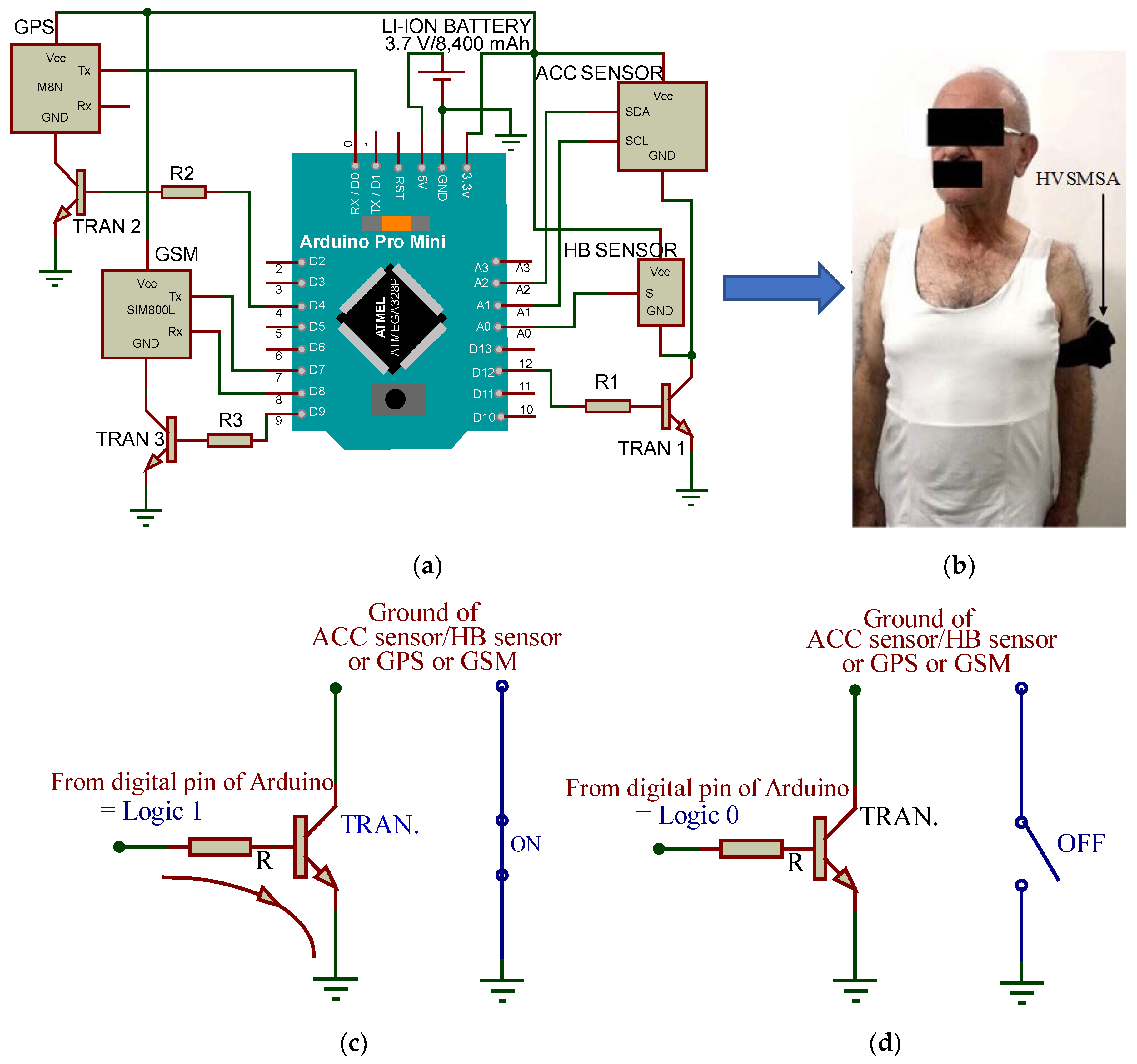




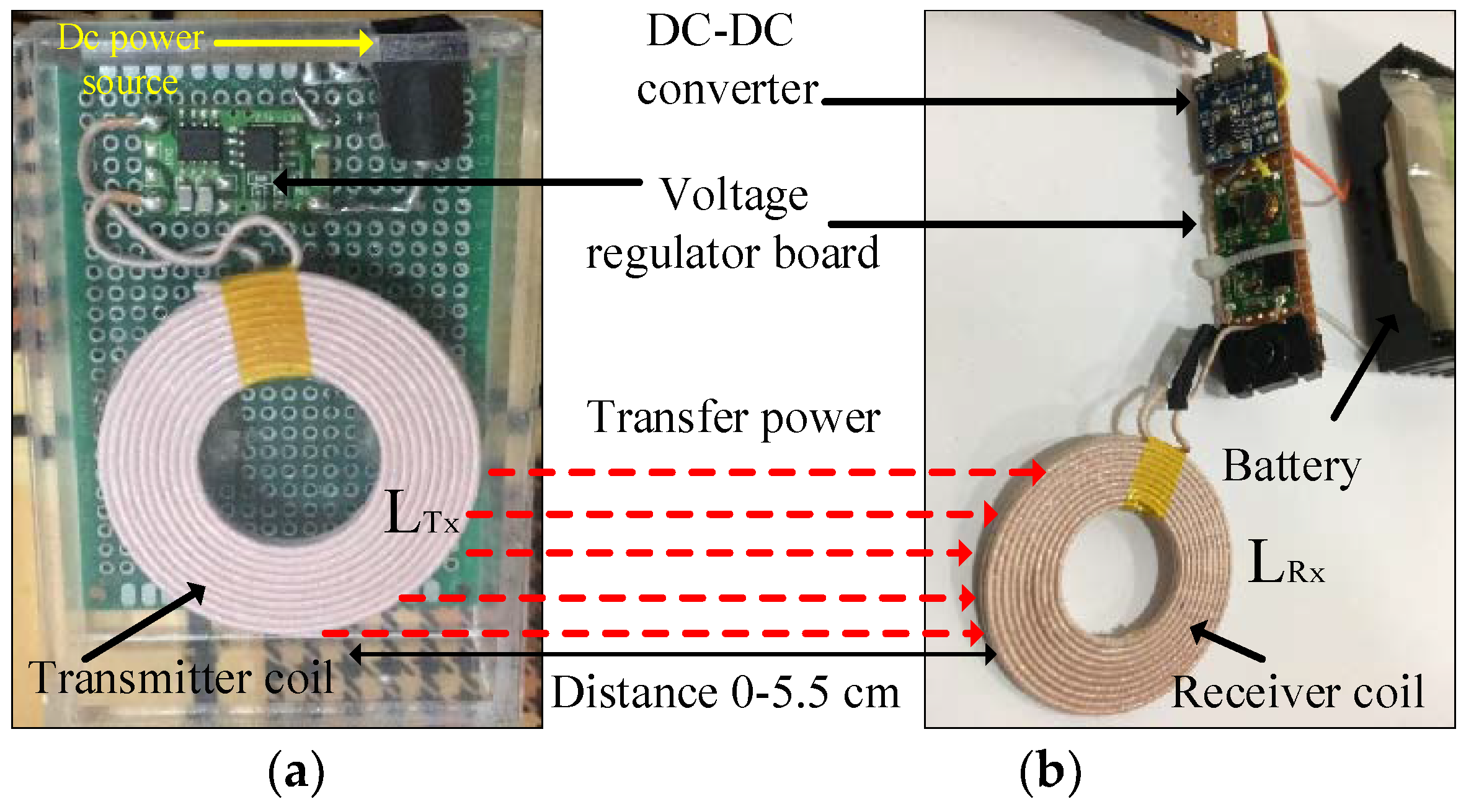
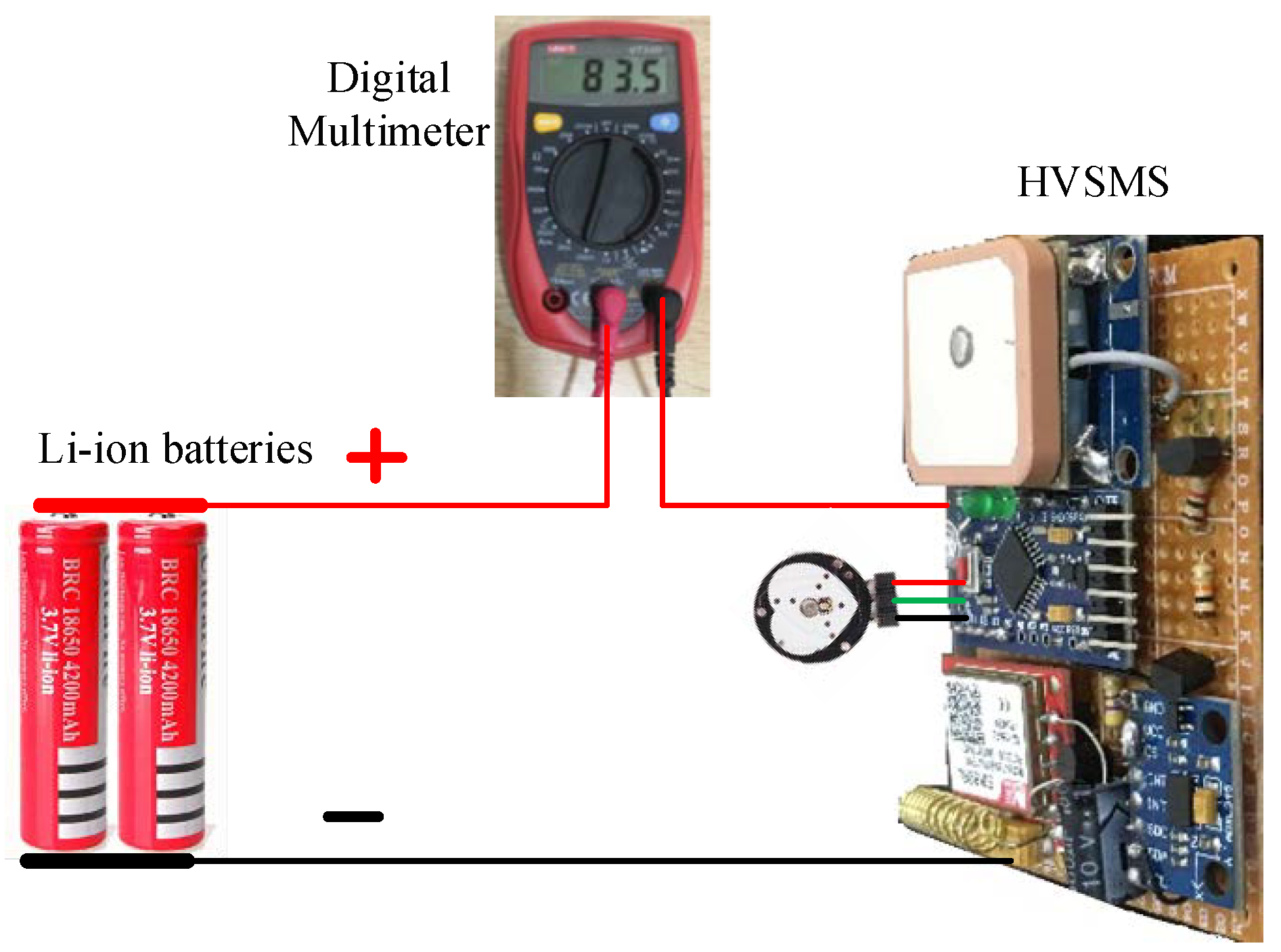
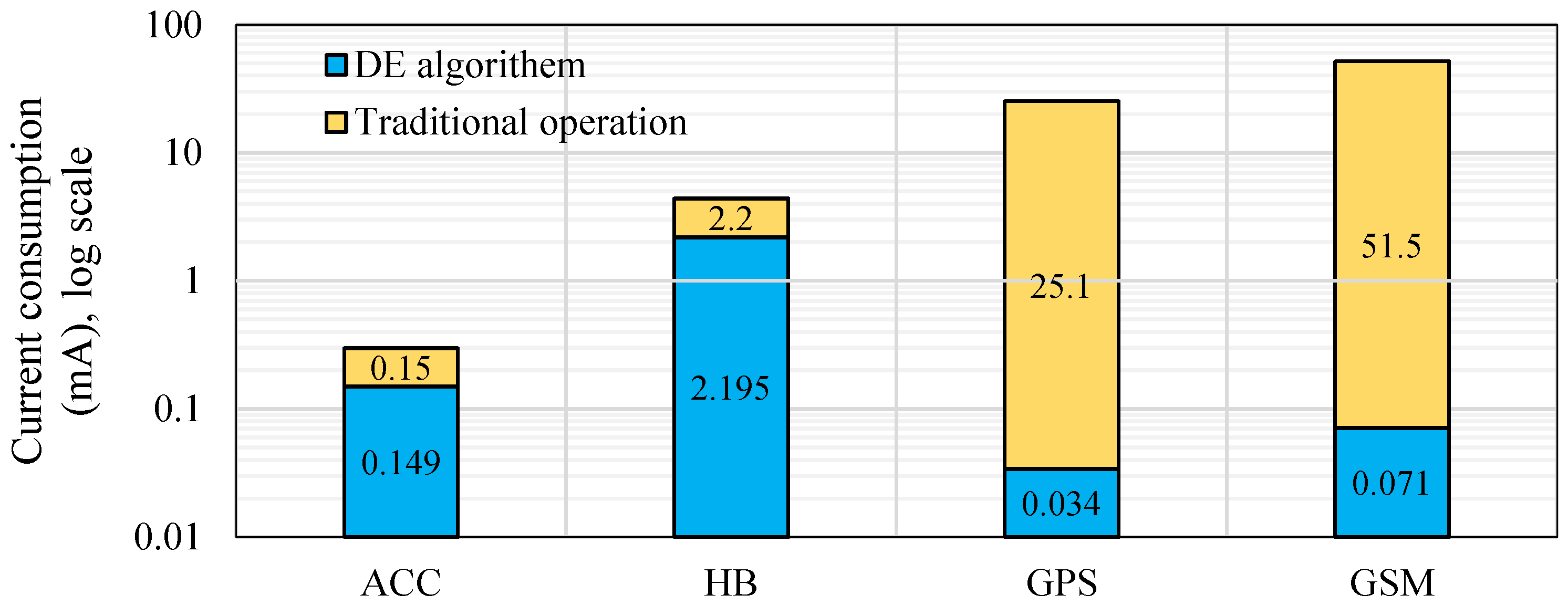
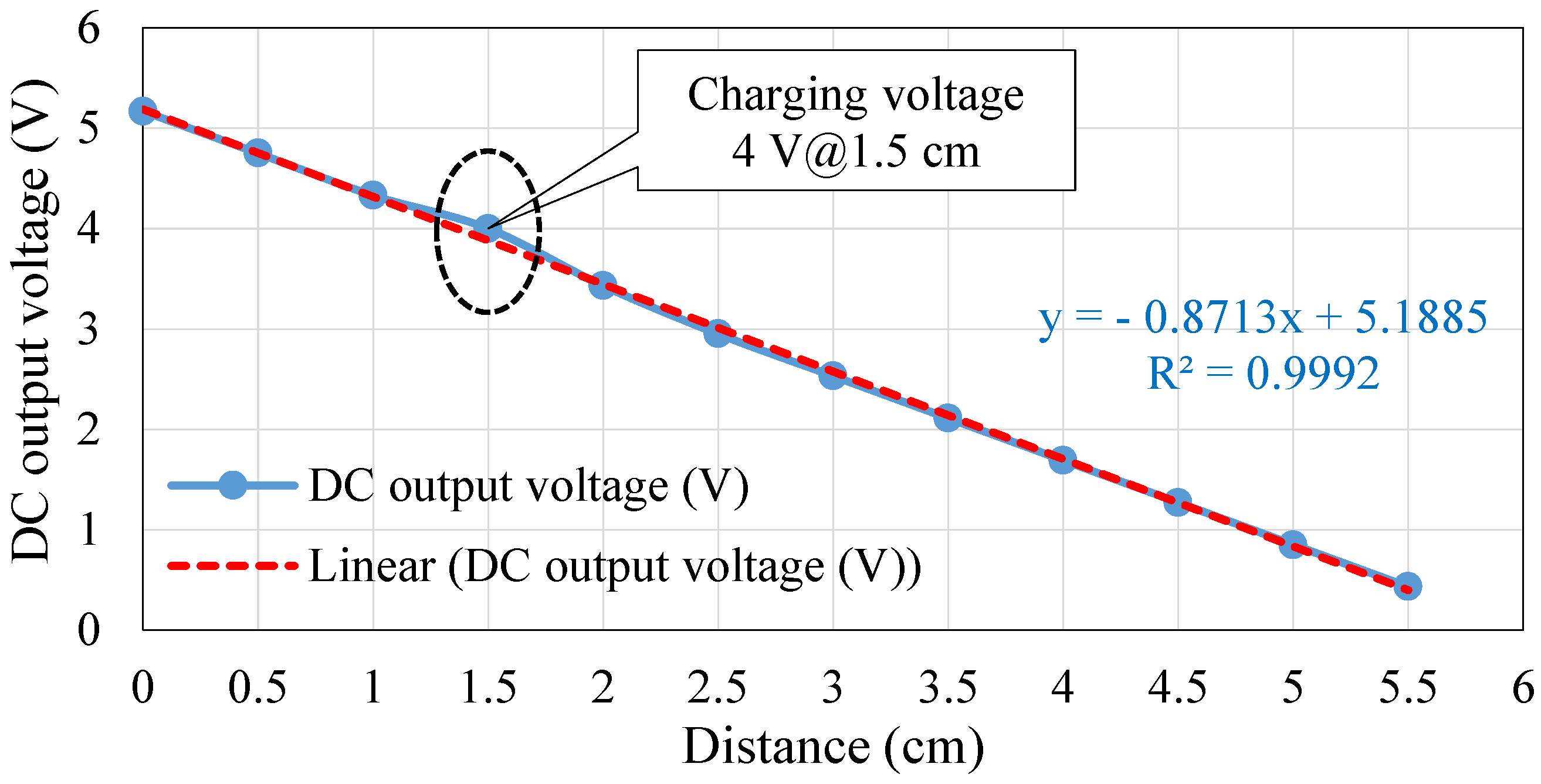

| Parameters | Standard Values [51] | Selected ACC Threshold |
|---|---|---|
| FDT | 0.313–0.563 g | 0.5 g |
| FET | 20–70 ms | 45 ms |
| Parameter | HB Sensor | ACC Sensor | Arduino Pro Mini | GPS | GSM |
|---|---|---|---|---|---|
| I (mA) | 2.2 $ | 0.15 $ | 6.9 *,& | 25.1 $ | 51.5 & |
| IDE_Avg | 2.195 | 0.149 | 6.9 | 0.034 | 0.071 |
| TBfall (minutes) | 1438 | 1438 | always on | 1438 | 1438 |
| TAfall (minutes) | 2 | 2 | always on | 2 | 2 |
| DC1 | 0.998 (1438/1440) | 1 | --- | ||
| DC2 | --- | 1 | 0.00138 (2/1440) | ||
| Isensing_DE_Avg = 9.2453 mA | Equation (5) | ||||
| Iwireless_DE_Avg = 0.1057 mA | Equation (9) | ||||
| Itotal_traditional = 85.85 mA | Equation (11) | ||||
| Itotal_DE_Avg = 9.35 mA | Equation (13) | ||||
| Power savings = 89% | Equation (14) | ||||
| BatteryLT in traditional operation= 97 h (4 days) | Equation (15) | ||||
| BatteryLT based on DE algorithm = 718.7 h (30 days) | Equation (15) | ||||
| Parameter | DE Algorithm | Traditional Operation |
|---|---|---|
| Current consumption (mA) | 9.35 | 85.85 |
| Battery life time (h) | 718.7 (30 days) | 97 (4 days) |
| Power savings (%) | 89 | ------ |
© 2019 by the authors. Licensee MDPI, Basel, Switzerland. This article is an open access article distributed under the terms and conditions of the Creative Commons Attribution (CC BY) license (http://creativecommons.org/licenses/by/4.0/).
Share and Cite
Kamel Gharghan, S.; Saad Fakhrulddin, S.; Al-Naji, A.; Chahl, J. Energy-Efficient Elderly Fall Detection System Based on Power Reduction and Wireless Power Transfer. Sensors 2019, 19, 4452. https://doi.org/10.3390/s19204452
Kamel Gharghan S, Saad Fakhrulddin S, Al-Naji A, Chahl J. Energy-Efficient Elderly Fall Detection System Based on Power Reduction and Wireless Power Transfer. Sensors. 2019; 19(20):4452. https://doi.org/10.3390/s19204452
Chicago/Turabian StyleKamel Gharghan, Sadik, Saif Saad Fakhrulddin, Ali Al-Naji, and Javaan Chahl. 2019. "Energy-Efficient Elderly Fall Detection System Based on Power Reduction and Wireless Power Transfer" Sensors 19, no. 20: 4452. https://doi.org/10.3390/s19204452






